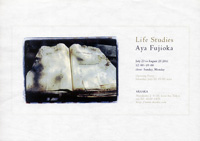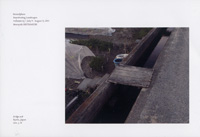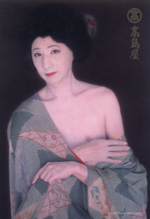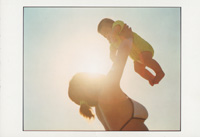 |
Picks is a monthly sampling of Japan's art scene, offering short reviews of exhibitions at museums and galleries in recent weeks, with an emphasis on contemporary art by young artists. |
 |
 |
 |
1 September 2011 |
 |
| 1 | 2 | |
 |
|
 |
 |
|
|
 |
 |
|
| Kiyoshi Yagi: "sila" |
| 1 July - 27 August 2011 |
Photo Gallery International
(Tokyo) |
 |
| Since 1994, Yagi (a graduate of the University of Alaska journalism department) has spent over 15 years traveling in the arctic and subarctic regions of Alaska, Canada and Greenland, photographing the native Inuit people who live in that harsh environment. This show and its companion volume, the just-published sila, chronicle their remarkable world. As Yagi explains, "sila" is an Inuit word meaning "all that is outside," embracing the entire cosmos as well as the spirit and order that pervade it. |
|
|
 |
 |
 |
|
| Aya Fujioka: Life Studies |
| 23 July - 20 August 2011 |
AKAAKA Gallery
(Tokyo) |
 |
| Hastily arranged to coincide with a rare trip home by New York resident Fujioka, this Tokyo show proved worth the visit. The photographer's new series, "Life Studies," captures daily life in New York, with people and objects floating forlornly amid zones of sharply contrasting light and shadow. Fujioka's forte is to aim always for the furthest corners of a scene, with a gaze so sharp that it sometimes seems to be scraping at a raw wound. |
|
|
|
|

|
 |
 |
 |
 |
| Masumi Nakaoka: less is more/more is less |
| 4 - 16 July 2011 |
O Gallery eyes
(Osaka) |
 |
| Rock quarries are the motif of all the works in this show. Besides individual paintings on canvas, Nakaoka also presents a large composite work of 32 drawings. The aggregate scene is of a quarry, but it is the parts rather than their sum that are of interest. Each drawing represents an element in which the artist has altered shapes or colors, imparting a sense of her own pleasure as she plays with different possibilities and discovers new imagery in the process. |
|
|
 |
 |
 |
| Kanoko Mori: lines. dots. |
|
|
Gendai Heights Gallery Den
(Tokyo) |
 |
| Mori's photos lovingly depict plates, pots, jars and glasses passed on to her by her grandparents. The utensils here transcend their function as kitchenware: they serve as conveyors of family memory, of a legacy for subsequent generations, and ultimately, as vessels brimming with both life and death. In Mori's images one senses not only the power of these objects' presence, but also the photographer's scrupulous devotion to the process of immortalizing them on film. |
|
|
|
|
|
|
|

|
 |
 |
 |
 |
| Stratosphere vol. 3: Motoyuki Shitamichi |
| 9 July - 13 August 2011 |
gallery alphaM
(Tokyo) |
 |
Since 2004 photographer Shitamichi has concentrated on his "Re-Fort" series, which chronicles his "re-use" of wartime ruins found around Japan. This was to be the sixth such show, but the March 11 earthquake shifted his attention to an entirely different motif: the small planks of wood and other materials that form makeshift bridges across ditches and canals. The uniformly high quality of the prints and the conditions under which the images were shot encourage the viewer to focus on similarities and differences among the scenes they portray.
|
|
|
 |
 |
| Ataru Sato: First Love |
| 1 July - 12 August 2011 |
Gallery Koyanagi
(Tokyo) |
 |
| Sato fills sheets of paper with densely penciled drawings of human faces and bodies. One may initially think of outsider art, or of the surrealistic detail drawings that have been popular in recent years. Sato, however, covers his margins with handprints, or adds collages in random spots, demonstrating that he is not interested in producing tidy miniatures at all. If anything, his figures reek of dread, perhaps of some sort of fearsome karmic retribution. |
|

|
 |
 |
 |
 |
|
| Yasumasa Morimura: Latest Works |
| 6 - 25 July 2011 |
Nihonbashi Takashimaya Gallery X
(Tokyo) |
 |
| In a departure from his recent series of macho-man impersonations, notorious self-portraitist Morimura turns his attention back to the opposite sex. His model here is the famed poster for the "Osaka in Kimono" spring exposition at the Takashimaya department store's Osaka branch in 1929. The poster, by Nihonga artist Tsunetomi Kitano (1880-1947), featured a demure kimono-clad maiden with one breast bared. The sensuality of Kitano's work no doubt strikes a chord with Morimura, as does their shared attachment to Japan's second city. |
|
|
|
|
 |
 |
 |
| Harumichi Saito |
| 6 July - 12 August 2011 |
A/A gallery
(Tokyo) |
 |
| At its new gallery in the 3331 Arts Chiyoda complex, the nonprofit group Able Art Japan showcases work by disabled artists. Photographer Saito, who is deaf and mute, is still young but is garnering increasing attention. In his "Absolute" series his subjects' faces are obscured by the sun, or the reflected flash of the camera, or backlighting -- yet the effect is straightforward and guileless. Works like "Tire" seem to be the product of impulses that defy articulation, but demand a second look. |
|
|
|
|
|
|
 |
 |
| Kohei Yoshiyuki: The Park |
| 29 June - 18 July 2011 |
BLD Gallery
(Tokyo) |
 |
| Yoshiyuki's legendary 1970s work -- nighttime shots of amorous couples and peeping toms in Tokyo parks -- would not have been possible without the technology of infrared photography. Yoshiyuki himself had to befriend the voyeurs and join their ranks in order to document this bizarre nocturnal world. But the watchers are even more his subject than the lovers; or rather, it is their collective ritual dance that forms a vivid testament to the power of human instinct at its most earnest and hilarious. |
|
 |
 |
 |
| Ayato Fujiwara |
| 16 June - 10 July 2011 |
gallery21yo-j
(Tokyo) |
 |
| Fujiwara's freestanding ceramic sculptures of small humans (five in the current show) are only a bit over a meter high. All share the same somewhat odd proportions: short legs, long arms, broader at the hips than the shoulders -- about as far from the Grecian standard of physical beauty as one can get. This reviewer thought it might be a commentary on the flaccid condition of contemporary Japanese, but the artist explained that it is not. Rather, this is a body type born of necessity, to give the statues a low center of gravity for stability. |
|
|
|
|
 |
|